by aramatzne@gmail.com | 18 Mar 2018 | Roads Taken
Part 5. The continuing saga. Still 1 June 2000.
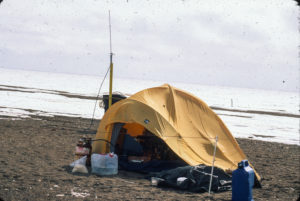
A little wind
In theory, the guillemots will be back within the week. Given the snow cover, the cold, now the pelting rain, I hardly expect them at all. It is hard to believe any creature would choose this place to start a family. It is, actually, quite beautiful and I am sure that when the snow melts, the pack ice recedes, and the 8’x10’ patch of tundra greens it will be even more so. There are Brant that nest here, greater white-fronted geese, and, in the past, large herds of Arctic terns. The snow buntings have been singing and chasing around since I’ve gotten here. I am happy to give them my oatmeal; they seem to enjoy it more than I do.
Although the sun has really not shown itself, I have been aware of its journey around the horizon. The difference in light during the day and night is muted by the hazy sky and heavy clouds, but the change in temperature is obvious. The first morning it couldn’t have been more than 15ºF – the radio said it was 19º at 5 am but I was up at midnight and it seemed colder. When I woke this morning, it was dead calm, and I knew something was coming. The wind now is out of the south, a Beaufort 5 or 6 (19-30 mph). The rain fly is pushed up against the wall rendering any waterproofness useless. The rain comes and goes. The wind continues.
The snow bunting sings its cheery, bright song. I drink more hot liquids. I wander out now and then to reinforce, stretch, fill garbage bags with snow for drinking water in July, empathize with the birds, scan for bears. I should be well read by the end of this.
The rain seems to have stopped. The wind has increased by a couple of notches. I am due for a radio call in ten minutes. I will be lucky if the antenna doesn’t blow off when I raise it. The white-crowned sparrow is still working the edges of the camp. There is a glaucous gull having an absolutely fabulous time playing in the wind, two Pomarine jaegers just screamed past. Perhaps the wind will blow out all the clouds and clear the skies. But, given that it’s from the south, I doubt it.
Aborted radio call. My sleep tent moved about ten feet across the island before I hauled more gear into it. The cook tent, where I’m sitting, is folded in half; sitting in the middle of the tent, the south wall is pressed against my shoulder. The fiberglass extender for the antenna wanted to shatter but flexed about in half trying not to. I guess everything that was soaked by the rain will dry in a short time.
The sparrow and bunting only come to feed when I am out of the tent, and I have my back to them. They will land 10 feet from me when they can see me standing there but not at all when they know I am in the tent. Buggers.
Hours later: The forces of good and evil are at work here, battling for control of the Arctic.
I just stepped out to take a photo of the tent being folded in half by the wind. I was barely able to stand against it but had to do something other than sit. I can see the bluffs six miles to the south. They stand out, clear and sharp. Immediately above them is a wall of cloud thick and heavy. Over me is another massive bank of cloud. Everything west and north is gray down to the horizon. Between me and the bluffs is blue sky. The wind is straight out of the west, off the Bering Sea. I can see the snow slanting across the lagoon and now and then there is a sharp spit of it right here. The wind has increased since this morning. I put a Halberton case full of books and a10 gal propane tank in the other tent to help keep it in place.
I just made another cup of tea. I shut the gas off earlier, afraid of the unpredictability of wind and fire. Given that both sides of the tent are almost directly over the stove I thought it might be a good idea. I shut the gas off again and finally was able to zipper shut the door – there are several broken teeth, which make it a challenge. Although it keeps the sand out and holds back the wind a bit, I am now cut off from the view – snow, ice, sky, and the occasional bird. It is much more claustrophobia-inducing this way.
I bought a wooden flute before I came here. I’ve wanted to learn to play for a long time and thought here no one would have to suffer through the initial squeaks. Each time I bring it out the wind seems to pick up.
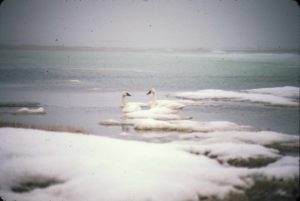
Swans stop for a visit.
Join me this fall on The Road not Taken Enough when I go to Svalbard on an Arctic Circle residency Artistry in the Arctic.
by aramatzne@gmail.com | 4 Dec 2015 | Roads Taken
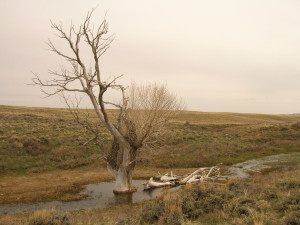
A few years ago I was sent to Wyoming to watch a red-tailed hawk nest. I spent days walking the sagebrush plains. I wrote the following during my days there.
There are places in the world where wind is an infrequent visitor. It arrives in advance of a storm and fades away as the storm passes. Perhaps it drops in like an old friend for a friendly afternoon tea and then goes merrily on its way. Wyoming is not one of these places.
My job this week is to get a red-tailed hawk used to people. I seem to give a new meaning to the phrase “odd jobs.” So here I sit in the middle of sage country with a lot of wind and few birds zipping by me. The ground squirrels chatter and squeak their alarm calls, diving into their burrows only to pop up again a few minutes later. The red tail comes and goes, truly disinterested in me or my meanderings around the place. An archeological dig is about to happen in this place; an ancient buffalo kill site is what they think is here.
All around me on this spring day is low sagebrush, molded to the ground by wind and cold. Last year’s flower stalks stand bravely against the unrelenting onslaught of moving air. A few grasses are scattered between; they too stand defiant. Mixed into this is the first push of spring flowers, delicate white flox being the most common and the lowest, with purple forget-me-nots and yellow prairie rocket tucked in here and there. There are some shrubby thorny things, the only plants to stand more than a foot or two off the dry, rocky, red-brown earth. In the draws, cottonwoods stand their ground. This time of year there is water; it courses past the old trees immersing their roots and lower trunks, giving them another year.
One tree in particular seems to have begun a new life. The south side of the tree, with tall, long extending branches is dead. The bark is completely peeled away, the trunk underneath bleached white. The north side of the tree has a width of bark still intact and a whole series of branches reaching skyward, buds thrown open to the early spring warmth.
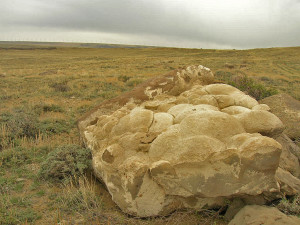
There are boulders strewn about, not lifeless rock but living stories. Many of these look like pillow basalt, the stuff created when hot lava meets cold water, cooling and setting underwater. These boulders are rounded globs of rock with a coating of limestone, like the beginnings of coral or mineral deposits left in a well-used teakettle. Some of them look like giant sheets of bubble wrap, others just random bowling balls left out in the sun. There are other rocks as well, flat slabs stacked and piled, alone and in clusters. These rocks tell no story of their own but they are covered with orange, yellow, white, green, and black lichens. Rings, splatters, and ribbons of color; lives of time.
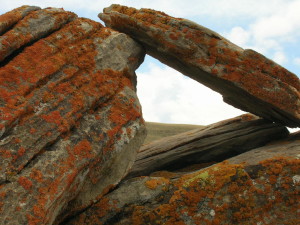
I found a buffalo horn high up on the ridge to the south yesterday. It is old. Long before man thought of pipelines or highways or windmills it happened there. The keratin is peeling and separating in layers; inside the horn all around the fraying edges are orange lichens, tiny beginnings of a new era. It gives me a small taste of the continuum of this land.
This is not a pristine place. Just to the south, not even out of earshot, is interstate 80. Through a narrow notch in the hills I can see the ceaseless stream of big trucks moving America. To the east, a long stretch of windmills rises from the land. I counted 165 but there is another bank to the northeast, mostly out of sight. Yesterday, this land of wind gave them a reprieve and they stopped moving for a short time. Today, they turn lazily, the wind still not up to its full strength. Running east to west right under where I sit is a pipeline. The scar for this major endeavor is remarkably nondescript, a thin line of grasses with sage encroaching. I believe this pipeline carries natural gas and next to it, is a fiber optic cable presumably for phones. Aside from this scar the only thing marking this pipeline is a series of random posts stating the pipeline’s presence and whom to contact before digging. I wonder if the badgers or ground squirrels ever call.
There’s a two track that follows the pipeline. This too marks the land, but here in the open, two tracks go everywhere. They are as unremarkable and unmarked as the wind.
Still, there is solitude here, a peace or perhaps just a calm that pervades everything. The sage, the birds, and I are waiting. The air will warm again, the sun will dominate, and the wind will be hot and dry. The peace comes from having nothing but the sound of wind in my ears, punctuated by the birds and ground squirrels occasionally. The calm comes from the expanse of ever-patient earth that also seems to be waiting. As if to say about the pipelines and highways and windmills, “This too shall pass.”
I try to think about days long ago when this plain was truly endless, when no roads, towns, or fences had cut it into pieces, when you could ride for days or weeks with only rivers to block your path. My mind is too modern, too confined to the easy path. The stamina and fortitude of the first people here is astounding; the determination of the first white settlers virtually unknown in this time.
I wonder how old some of these sagebrushes are. Their stems gnarled, twisted, and cracked, their branches lying over with the wind. They are a study in the area’s prevailing winds.
The archeologists have been digging and sieving for three days now. They have previously dated hearths here, one to 330 years ago and a second to 1200 years ago. Today they dug up an arrow point that, by its shape, is about 2000 years old. They have found bison and antelope bones with tool marks on them. Apparently elk kills are almost never found.
I’ve found a handful of ticks this last week. Usually at the end of the day, on my way home, I find them crawling on my pants or my sleeve. This morning I found a tick attached to my hip at my underwear line. Ick. It was just getting embedded; I picked it off and flushed it. I’ve had the heeby-jeebies all day. Every minor discomfort, itch, tweak, and twinge becomes a tick burrowing into my flesh. I don’t mind them so much when I pick them off my clothes or easily exposed flesh, like my calves or forearms. When I find them crawling up my neck and into my hair or when they are actually attached anywhere, they gross me out. Seeing them on vegetation at the tip of a branch extending themselves as far as they can reach, stretching, clutching like a small child desperately seeking to be picked up, well that’s just icky. No way around it.
When I was leaving the truck to walk earlier, I was collecting my camera and coat and field book. I looked up to see a big Black Angus bull meandering toward me. I waited in the truck. As I sat and watched he stopped in a spot of open soil, he looked at the truck and started pawing the ground, snorting, and lowing. The dirt went flying up along his back, his tail twitched back and forth. One foot, fling, the other foot, dirt flying. He moved a few feet closer, now about 50 feet away, stepped onto a ground squirrel mound and pawed the earth again, bellowing a challenge to the silver intruder in which I sat. He watched the archeologists, some on this side of the fence, some on the other. He bellowed again and then circled around the back of the pick up and turned northeast along the fence line. I followed, watching him pick through the sage and up into the brush, over the ridge and out of sight, my great wildlife encounter for the day.
The wind has returned to its normal potency today. Walking into it causes my face to stretch and pull away from my teeth. My mouth dries, my clothes adhere to my skin. Trying to stand, I get buffeted, tipped, and thrown off balance; walking with it, I fly. The sun is strong and warm but the wind whisks away that heat with my breath. The ground absorbs the heat and in small quiet pockets, among shrubs or in the depressions the heat lifts from the ground engulfing me with the scent of sage and momentarily making me think long underwear is too much for this day. Looking through my binoculars across the plain I can see heat waves, shimmering, distorting. As if there isn’t enough wind driven motion the heat waves add their efforts.
I’ve been picking up garbage as I walk. The highway is a great provider, Walmart bags, packing slips, shipping manifests, hotel receipts, coffee and soda cups, oil containers, chip bags, sandwich wrappers, beer cans, even a kid’s disk sled. The pipeline contributed dozens of yards of blue, pink, and orange flagging with a smattering of green and yellow thrown in for variety. The wind hurls these things great distances until they finally snag in a shrub or get so tangled in grasses or fencing that they can no longer move. There are always enough plastic bags flung into shrubs to collect the other garbage I find. I have become a high plains bag lady.
This morning as I was walking I found an arrowhead. It was lying in the path, just so. I had cut across a steep sandy bank above the creek and found a fox den. It was the perfect spot, invisible from the ledge above, steep and sliding sand protected it from below. I stopped to look back at it from the bluff to see how the boulders were protruding from the eroding bank and how one of these blocked sight of the den entrance from the other side. As I turned back to the cow path at the top of this bluff the arrowhead leapt into view. It is small but nearly perfect, the brown color of pipestone. I think it is a reward for packing out the garbage, a token of appreciation for just paying attention and for remembering that this was not a dump but that there had been lives here before.





